Pavement Management Systems in Small & Medium Size Local Governments in Texas
Info: 8271 words (33 pages) Dissertation
Published: 10th Dec 2019
Tagged: Public Sector
ABSTRACT
Pavement management is defined as a framework which ensures the quality and performance of the transportation pavement maintenance. It helps to lower maintenance costs by using good management practices. Pavements management systems combine all the set procedures for data collection, analysis, maintenance and reporting in finding optimal strategies for the maintenance of transportation pavements in good serviceable condition over a specified period and for the minimum costs. Pavement management frameworks assist manager to obtain/get an informed understanding of the possible consequences of alternative decisions. Pavement management system(PMS) does not necessarily make the decision but instead, they assist the decision makers to make a wise decision concerning the pavement management.
This report aims at discussing the processes that are carried out in the execution of PMS. It compares the advantages of rehabilitation with those of constructing a new pavement network. It also aims at realizing the best practices of PMS. A survey was carried out using questionnaires which were distributed to local governments from Texas. The survey data is presented in an appendix form. Analysis of the collected data is purely based on the conditions of the pavements, reaction of the respondent and the success of the already tried method.
Table of Contents
2.4 PMS as a Decision-Making Tool
3.1 Pavement Management in Small & Medium Cities
3.2 Survey Questionnaire and Outline
Survey Questionnaire & Responses
LIST OF TABLES |
|
| TABLE 4.1 Cities population and area (square. Miles) which are responded.………………….16 |
CHAPTER 1: INTRODUCTION
Rising materials costs mandated the managers of our infrastructure looking for better and more practical approaches to allocate resources. With these rising costs, the estimation of our set up materials rises and turns out to be costlier to keep up with an adequate level of performance.
It’s the nature of the pavement’s condition to deteriorate at an increasing rate. At the first stage, the pavement tends to have few distresses, and the pavement is in good condition. Distresses tend to increase as the pavement tends to age. This makes it easier for the pavement to damage. As the pavement tends to age, its condition can be improved and maintained by maintenance and rehabilitation. Maintenance tends put the rate of damage at standstill, primarily through correcting small pavement’s damage prior to their spreading. At this point, rehabilitation procedure is applied.
1.1 Project Objectives
This project is focused on with the pavement management system. It aims at helping the decision maker make wise decisions that will see the cost of pavement maintenance drop by a significant figure. To achieve this object, there are some main objectives that this project is set to achieve.
- Being informed of the practices which are used to maintain the pavement, all the processes from assessing the distresses, determining the level of damage, the technique to apply and the cost of the process applied.
- Identify the most used practices which are best suited for the maintenance of the project. Among preventive treatment, rehabilitation and reconstruction, which is the cheapest and the most convenient method.
1.2 Pavement Management
Pavement management is the process of planning the maintenance and repair of a network of roadways or other paved facilities in order to optimize pavement conditions over the entire network. It is also applied to airport runways and ocean freight terminals. In effect, every highway superintendent does pavement management.
This project will asset managers in small and medium-sized local governments gain a better understanding of the practices used for pavement used for transportation. It will also enlighten us on the practices which are best for the maintenance of the pavement system in this size networks. Budgeting, preserving and maintaining of the pavement is a major activity for the government in Texas. Local government and all the other parties that are concerned with the maintenance, experience the problem of inadequate resources to maintain the pavement as well as other infrastructure. Due to this reason, the funding for pavement management should be used effectively. To help in pavement maintenance, pavement management system was established in the year 1991 by the intermodal surface transportation efficiency act. Implementation of PMS, help small agencies to save funds for other capital improvements.
The local governments, as well as the state department of transportation, have continued to invest heavily in the pavements maintenance as well as improving their conditions. For the funding to be effectively utilized and for the pavement network to be often maintained, there must be sound decisions made. Pavement management includes the proof of ideal techniques at different administration levels as well as the execution of these techniques (Dave Johnson, 2017).
1.3 Research Objective
The basic purpose of this project is to examine and analyze Pavement management practices in various cities in Texas state.
CHAPTER 2: LITERATURE REVIEW
All materials depreciate after some time due to usage or due to exposure to the environment. Pavement network is no different or special. After some time of usage, or by being exposed to the environment, they start to wear out (www.asphaltinstitute.org, 2017). Pavements weaken after some time from being exposed to the frequent traffic as well as being exposed to the environment; the humidity level, the temperature, emissions and heavy loads on the pavement increases the rate of the pavement deterioration.
A PMS is a set of instruments or, on the other hand, strategies that help decision maker in finding ideal procedures for giving and keeping up pavements in a proper serviceable state over a given period. Without sufficient schedule on pavement maintenance program, streets and roads in this manner costing the state and the local governments millions of additional dollars (Dave Johnson, 2017). The work of a PMS is to make the productivity of choice making, give input on the results of decisions, facilitate the coordination of exercises inside the office, guarantee consistency of choices made at extraordinary administration levels inside the same organization. The total and final decision-making process are based on data from PMS coupled with designing and engineering experience, financial plan limitations, planning parameters, administration rights, political contemplations, and arranging and programming factors. PMS can provide huge benefits both at the network and at the project levels. Agency-wide projects of new development, maintenance or rehabilitation~ having the slightest aggregate cost, or most noteworthy advantages, over the close examination period, are created at the system level (www.agileassets.com, 2017). At the task level, nitty-gritty thought is given to development, support or rehabilitation exercises for a specific area or undertaking inside the general program which will give the coveted advantages or administration levels, in any event, add up to cost over the investigation time frame.
2.1 Rehabilitation Options
Every alternative’s adequacy is reliant upon a large number of nearby conditions – climate, movement, surface and subsurface conditions, and so forth. Maintenance alternatives should be assessed and used based on local conditions, including the accessibility of innovation (www.asphaltwa, 2010). While pavement maintenance can mitigate the rate of deterioration, it cannot prevent harm from happening. In this way, the impacts of deterioration, in the end, should be turned around by including or supplanting material in the current asphalt structure. This procedure is restoration.
Restoration alternatives rely on local conditions and pavements defects type, however, most common restoration types are:
- Cold in-place recycling-(CIPR)
- Hot in-place recycling-(HIPR)
- Full-depth reclamation-(FDR) and
- Hot mix asphalt-(HMA) basic overlay
Rehabilitation turns around the impacts of decay by including, supplanting or reusing material in a current asphalt structure. The incorporation of reusing procedures might advance on many levels. To begin with, it reuses set up materials that are regularly a portion of the best materials accessible. Second, it is frequently an exceptionally choice contrasted with reproduction (www.asphaltwa, 2010). Third, the interruption to people, in general, tends to be less as the street can regularly be utilized amid the restoration work. Particularly in urban settings, this can significantly diminish client costs related to an undertaking.
Both are reusing and recreating right a heap of troubles in a solitary exertion. In any case, with reusing, the office may organize the development ventures into suitable stages over expanded time. Arranging changes can diminish the assets expected to address a street today, while as yet amending issues temporarily. Resulting stages accommodate a long-haul arrangement, with the consummation of all the arranged stages (Johnson, 2017).
2.2 Treatment of distress
A general pavement decay show is found in the going with a figure. It graphically shows that, by and large, once asphalt needs treatment, the sooner and maintenance or recovery action is embraced, the more practical it will tend to be. Notice that for the initial 75 percent of asphalt life, the asphalt condition drops by around 40 percent. Be that as it may, it just takes another 12 percent of asphalt life for the asphalt condition to drop another 40 percent (Johnson, 2017). Furthermore, with a specific end goal to reestablish asphalt condition to a pre-decided level, it will cost four to five folds the amount if the asphalt is permitted to disintegrate for even a few years past the ideal restoration point.
All recovery or renovation activities should utilize some level of financial assessment to decide the savviest strategy and timing. The utilization of a very much planned asphalt administration framework or commonly known as Pavement Management System that is custom-made to the individual organization can be a profoundly helpful means in supporting the basic resource allocation process (www.fhwa.dot.gov, 2017). Administrators ought to be wary to not see a PMS as a black box that has every one of the appropriate responses. The requirement for sound designing judgment remains. A PMS can help with making those judgments. The level of refinement of the PMS can run from a basic paper-just database of data to a client composed spreadsheet to an exceedingly created PC information framework. Jurisdictional needs and spending plans should be considered while deciding the level of advancement to seek after (Farrukh Sohail, 2006).
2.3 System Capabilities
A PMS is a framework that joins parts and procedures to create proposals to the client. The parts are by and large subdivided into arranging level (enormous picture) and undertaking level (centered point of view) things. This incorporates office areas, surface types, past development and support exercises, budgetary assets, and framework conditions and objectives.
At the venture level, venture limits, singular trouble studies, venture spending plans, building data, venture outlines, and allowing and right-of-way prerequisites are archived. This information is prepared by the PMS to create proposals. The suggestions are then breaking down and audited to decide their impact on the framework and their convenience in achieving pre-set up objectives. This procedure is much of the time iterative as results are examined and options investigated.
In its most astounding structure, that of a PC database, a PMS will create reports, diagrams, and tables. The reports may incorporate forecasts of future conditions and budgetary needs, authentic conditions, and it might offer prioritization systems. Diagrams or charts and tables can be helpful in outlining the data from the reports in an arrangement determined by the client.
2.4 PMS as a Decision-Making Tool
At the point when a road framework is seen from a comprehensive viewpoint, it can be developed, kept up and restored proficiently. To accomplish the objective of building and keeping up a practical and dependable road framework, current pavement conditions, future support and restoration needs, expected new development, and evaluated budgetary assets are mixed with authentic conditions and development and upkeep exercises into a basic leadership framework intended to help specialists and organizers in utilizing and looking after infrastructure (Farrukh Sohail, 2006).
Normally when a PMS is executed, it can be a precious means of choosing where and when pavement development, maintenance, and recovery endeavors ought to happen. At the point when well done, a PMS expels singular subjectivity from the procedure and to deliver fair-minded choices. Also, it enhances the general nature of the street framework while expanding the available dollars for the framework (www.pavementinteractive.org, 2010).
2.5 Treatment Options
The levels of treatment to correct pavement deterioration include:
- Periodic maintenance (e.g., slurry seals, surface treatment, and non-structural [thin] overlays). This process is different from routine maintenance treatment. It is applied to the pavement even way before they show any sign of distress. The main objective/primary of this process is to extend/prolong the life of the pavement by instilling the positive attributes of the pavements (www.nra.co.za, 2017). They delay the deterioration process of the pavements and also furnish any possible existing distress. Due to that, they can be termed as either corrective or preventive method of pavement management. Periodic maintenance is further divided into various work types such as preventive treatment and resurfacing (www.nra.co.za, 2017).
- Rehabilitation (e.g., structural overlays or set up reusing). These are the structural fittings that increase the service lifespan of an already existing pavement. The other purpose of the rehabilitation is to improve the load carrying the power of the pavement. Some of the rehabilitation techniques are the structural overlays and restoration treatments. Rehabilitation projects achieve their goal by either restoring the destroyed structure of the existing structure through the removal of destroyed pavement and replacement by a new one or by thickening the pavement layer. This technique is best suited for destroyed structure. Rehabilitation procedure is much expensive than preventive measures (www.scdot.org, 2015).
- Reconstruction (e.g., outlines, design and build another road). This entails designing of another pavement and rebuilding it again. It is the last option when other options are not applicable.
The maintenance of the pavement depicts every one of the strategies and systems used to improve and increase the pavement life by moderating the deterioration rate. Recreating a whole pavement, in any case, isn’t considered rehabilitation but instead new construction because the strategies utilized are by and large those created for new pavement construction (www.constructionequipment.com, 2016). Pavement life cycle, life cycle cost analysis, and pavement administration are altogether utilized when setting the type, timing, and degree of maintenance and rehabilitation activities.
- Implementation of PMS comes with many benefits. It cuts the cost of rehabilitation as well as that of constructing a new one. Benefits associated with effective implementation of PMS include:
- It provides an incorporated area to pavement stock condition data, development, support, and recovery records
- Giving a technique to investigate the results of different subsidizing levels on pavement conditions
- Enhancing booking of pavement works; helping as a basic leadership apparatus in upgrading recovery, upkeep, and exchange of alternatives
- Giving the data expected to examine the cost-adequacy of treatment repairs
- Enabling an organization to reply “what-if” sort questions in regards to asphalt.
- Repair projects and financing levels.
- Advocating spending needs to choose authorities and stakeholders
Costs associated with managing pavements include software acquisition, software installation, training of the personnel to install, the collection of data, building of the database and general maintenance of the system (Farrukh Sohail, 2006).
There are various factors that call for the efficient management of pavement operations. Investing in pavement management is a positive activity as it provides the tools that are needed by various agencies in addressing the management drawbacks. The process of designing a pavement management process involves several processes. These steps are discussed below.
- The process of defining the Roadway network as well that of collecting inventory data; outlining pavement management process is to characterize the roadway network. A roadway network has involved a stock of the physical attributes of the roadways being overseen. After sections are characterized in a way that best fits the requirements of the given organization, the stock data for each section is gathered by either evaluating the information or gathering all required data. The correct sort of stock data required by an organization relies upon what information will be utilized by the organization to help its choices.
- Collection of condition information – Pavement condition information is a central point in any data-driven, basic leadership asphalt administration process. Inside the pavement management process, the condition information can be utilized to help distinguish current support and recovery needs, to foresee future needs, and to evaluate the general effect on the system. In this way, the kind of condition information required, and the level of detail relies upon the organization and the asphalt administration process utilized. Condition information will be gathered utilizing either manual or computerized information accumulation strategies. With either technique, information will be assessed or measured.
- Predict Condition – With current asphalt condition surveyed, offices are equipped with the data expected to anticipate the future state of a fragment. In asphalt administration, conditions are anticipated as far as execution models that gauge the normal rate of asphalt crumbling every year. Asphalt conditions can be anticipated for the asphalt arrange to utilize either normal decay rates or execution expectation models
- Selection of treatment – The next step in planning the asphalt administration process is to choose suitable treatment for the roadway to organize. Treatments are chosen utilizing recurrent calendars or treatment trigger guidelines. The prescribed treatment is then organized utilizing positioning or advantage/cost examination.
- Reporting the results – Undertaking results can be accounted for utilizing diverse strategies to feature imperative variables which will help chiefs with their official conclusions. Data revealing is a viable strategy for imparting not just the suggestions from the asphalt administration process yet additionally exchanging related data to chiefs. The information can be utilized to create reports and diagrams to remove pertinent data relating to any section under consideration. The outcomes can be exhibited either by utilizing standard outlines and reports or tweaked synopses
- Selection of pavement management tool – The determination of an asphalt management tool is affected by the prerequisites of the office and client’s needs. The apparatus gives a stage to store the asphalt administration data and to perform diverse sorts of examination relying upon a spreadsheet, GIS apparatus, as well as an asphalt administration framework (open or private) is chosen.
- Keeping the process current – Pavement management is a continuous process which needs constant updates. It is not a one-time activity, and thus regular check-ups are needed. The concerned agencies must make the required efforts in updating the information which is necessary for the pavement management system. The information must be kept current as data management is a key component.
CHAPTER 3: METHODOLOGY
Based on an assessment of pavement management practices in cities, the cities selected are small & medium sized cities from Texas state, 40 cities are selected, and an online survey is conducted. Authorities in these cities provided some information about their practices in characterizing framework performance objectives; in arranging and programming; in the gathering, storage and utilization of information; in program usage; and in program observing.
3.1 Pavement Management in Small & Medium Cities
Cities are detailed the utilization of genuinely propelled rehearses in the storage, accumulation, and analysis of information. They additionally utilize an extensive variety of contracting strategies to secure the administrations of private temporary workers for some exercises running from development to information collection (Improving Public Sector Property Management. Office Politics. , 2012). They usually have solid strategies for characterizing framework execution targets, utilizing strategic plans and civil involvement systems. In favor of concerns, many announced that their essential project choice criteria were “most noticeably first,” which would propose the great intentions in the gathering and analysis of information and the work in strategic speculation may not be completely used.
Correspondingly, on the “delicate” side of hierarchical issues, guaranteeing that the whole association progresses in the direction of similar objectives, most of the cities keep on having challenges.
3.2 Survey Questionnaire and Outline
To assess and know the performance, the results and the failure of implementing or failing to implement the pavement management system, research was done. The project information was collected using questionnaires. The questions in the research report were mainly focused to get answers on how the execution of PMS reduced the cost maintaining the condition of pavement network.
The analysis was made based on the various ways of maintenance as well as rehabilitation. This information was collected by a questionnaire conducted through the distribution of questionnaires in Texas. Not all respondents finished all parts of the survey. This report confers the questionnaire results completely, showing the same aspect of questions as modeled. The responses which were provided by the members who took part are tabulated and compared. To get a better understanding of the operations that are undertaken in the PMS, a survey questionnaire was conducted.
The survey questionnaire was sent to transportation departments of different cities in the State of Texas. The questions give structure to comprehend the impacts of data, frameworks, and information inside resource administration and operations in organizations. The intention of the survey is to collect the information on pavement management practices of different cities. The questionnaire also gives people of organization a good chance to share their general feeling on how the PMS is functioning. It gives the appellant a chance to evaluate some of this bureau that is assigned with the purpose of executing PMS.
Framing the questions in a simplified way and being to the point about the latest methods of PMS and to know the recent information about the PMS. The reason for building up this kind of Questionnaire was to make it easy for the officials of the transportation department to attend it besides their busy schedule.
3.3 Data Analysis
This research analysis was carried out based on a variety of traits concerning the pavement management which are interlinked with the infrastructure assets which comprises of the vital basis of the specialized direction form of the management, the crucial means of dealing with the planning ordeals and the results of conservation plus the issues of operational maintenance. On the concern of the assessment of the profitability of the project to the lives of the public there are some crucial segment that are supposed to be considered starting from the selection of resources, the representation of the distinctive materials to be utilized, the innovation of data capacities that are accessible to be able to offer a greater assistance to the organizations. Further the project should initiate to review the transportation destinations that are normally served by keeping up the selected resources of a good nature.
The research was steer headed by a survey that was conducted in which they collected the information using questionnaires that were distributed. From the survey not all the respondents finished the sections of the poll, as a result, the number of reactions with vital information in this format changed the overview part. Therefore, this report conveys the survey report that shows the same aspect of questions as modeled. In which the response that was provided from the survey were tabulated and then compared.
3.4 Bibliography:
The questions in the survey were taken from the following: The National academics of science engineering medicine; Common Pavement Maintenance Practices (2011); NCHRP Synthesis 401 (Quality management of pavement conditions data collection). Most of the questions were taken from books mentioned above and then, modified and updated further.
CHAPTER 4: CONCLUSION
It is concluded through this literature that pavement management has led to a rising set of improvising their quality of pavement where the outputs comes with the development of the pavement. The increase in the pronounced importance of these has been displayed in the survey that has been conducted which concludes that the aspects which are important are the budgets. Analysis of collected data were done between the forty cities of Texas. Average results from these cities (Corsicana, Frisco, Schertz, Edinburg, Pampa, Brenham, McAllen) who responded for the survey are analyzed in this report.
| City | Population | Area (sq.Miles) |
| Corsicana | 23,987 | 23.28 |
| Frisco | 168,140 | 62.4 |
| Schertz | 34,883 | 28.6 |
| McAllen | 142,212 | 46.26 |
| Edinburg | 87,650 | 37.4 |
| Pampa | 17,994 | 9.5 |
| Brenham | 15,716 | 9.8 |
Population and area (sq. Miles) of Named Cities
TABLE 4.1 Cities population and area (square. Miles) which are responded.
The above cities have different ways of managing their pavement network. There are those cities which neglect the pavement to a point of destruction though very rare. Many cities prefer rehabilitation of the existing pavement because it is a convenient and cheaper way. Some of the cities have pavement management system put in place.
Calling them medium and small cities four cities (Corsicana, Frisco, McAllen, Edinburg) have PMS, Schertz is presently developing PMS and other two cities do not have PMS. PMS in medium cities is functional but requires some improvements in city streets but in small cities, it doesn’t even applicable. In medium and small cities, In-house staff is involved in PMS but in big cities, In-house staff with outside support is involved.
Many of the medium cities have selected sections of pavement that require rehabilitation treatment or maintenance by the aid of computer programming, by the worst pavement conditions, and takes other conditions which are not mentioned, but small cities select by engineering judgments, & by operational priorities. Mostly all the medium cities methodically identify pavements which would benefit significantly from preventive treatment, but some identify when budget permits and small cities cannot identify pavement treatment. All the cities apply preventive maintenance treatment, but some cities only apply at the most appropriate time.
Cities get funding based on last year budget for routine pavement rehabilitation and maintenance, but small cities have issued significant fund for preventive treatment, & gets funds based on demands to preserve pavements. In medium sized cities Staff is devoted to PMS, but in some small cities staff is not devoted to PMS. The final decision on maintenance and reconstruction project in medium cities is by City Commission whereas for small cities it was made by Administration work director. The pavement data is saved in financial information database and pavement management database in medium size governments whereas in all other cities it is saved in the internally created database. In small size cities data is collected annually for PMS but in medium-sized cities, data is collected for every three years and five years simultaneously. Usually, software packages used for PMS are Micro Paver, Airpath, PaverTM, but all the cities used Micro PAVER & manual software i.e., spreadsheets.
Based on the data collection standards and based on the recorded practice and the staff experience denied by the firm, these statements decide which information obtained to support the selected projects for the cities which are based on needs of individual or integrated management system/decision processes to be supported. The estimated budget for the roadway pavement varies with all the cities. The allocated budget for the maintenance of roadway pavement for the cities Edinburg, Brenham, Schertz, Pampa, Corsicana, Frisco, McAllen is 2.75 Million, 1.5M, 2.5M, 50K, 1.5M, 1.5M, 3M respectively. Location, Structural condition, Functional condition, User complaints, and Utilization are most crucial view for roadway pavement between a bridge and pavement project in this Structural condition is taken into consideration by cities. The final results of pavement administration system are utilized to track the pavement condition by the small-sized cities and to analyze the performance of the previous pavement rehabilitation treatments and maintenance by medium-size cities.
This project’s conclusion can also be based on the engineering practices; for instances treatment and rehabilitation of the pavement system instead of waiting for the pavement network to completely wear out so that it can be reconstructed. From the research, rehabilitation has always saved the government some money and because of this, it is recommendable to rehabilitate instead of reconstructing. Agencies which have been given the role of managing and ensuring that the pavement networks are in good condition ought to do a thorough check-up to ensure that small pavement destruction is repaired before extending.
4.1 Further Analysis
The below improvements that have been analyzed are based on the survey that has been conducted by sending the questionnaire to the Transportation Department in the cities of Texas. First in some small cities, the pavement management systems have not been implemented due to which the pavements are undeveloped therefore the need for implementing and developing an effective pavement management system(PMS) is required. According to the analysis, the pavements are not examined during the appropriate time for preventive treatment, this should be changed by examining them when required. In most of the cities, the budget is allotted for the present year’s PMS are based on the analysis of the previous year’s budget. The reason for this kind of allotment is the assumptions that repairs which have occurred in the previous years would recur back in the present. This method has its own drawbacks as the assumptions that are taken could be false and lead to failure of PMS. Therefore, the suggested method for budget allotment could be based on the analysis of conditions of the pavements. The efficiency of the PMS can be increased by appointing full-time staff rather than part-time. Decisions for repairing the old projects or construction of new projects should not be based on a single member, a committee should be held and collectively take a joint decision. To avoid confusion in different database uniquely for PMS i.e., the data should not be mixed with one and other. Card file and Spreadsheet should be avoided. PMS software packages such MicroPAVER, AirPAV, PaverTM, should be used to get a better analysis. Skilled engineers should be appointed to take care of the cities pavements for their good condition and longevity. Finally, the above-mentioned improvements could be implemented for the betterment of the pavements.
APPENDIX
Survey Questionnaire & Responses
- Does your agency handle a Pavement Management Framework?
 Under development
Under development- Yes
- No
- How does the pavement management system improve your city streets?
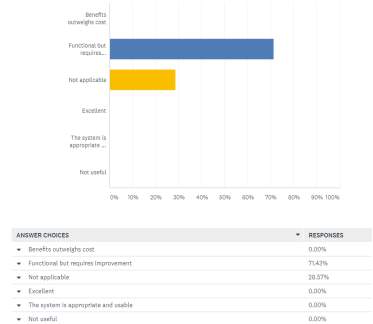 Benefits outweighs cost
Benefits outweighs cost- Functional but requires improvement
- Not applicable
- Excellent
- The system is appropriate and usable
- Not useful
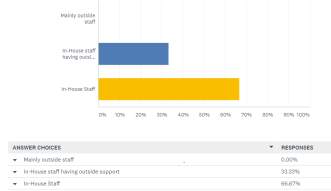 Who is involved in your Pavement Management System?
Who is involved in your Pavement Management System?
- Mainly outside staff
- In-House staff having outside support
- In-House Staff
- How do you utilize the final results/outcomes of pavement administration system?
- To predict coming year’s pavement deterioration
- To track the pavement condition
- To analyze the performance of the previous pavement rehabilitation treatments and maintenance.
- To design a fully functional Capital Improvement framework or annual budgets

- How do you determine the condition of pavements?
| Pavement evaluation procedure
|
If yes, the frequency of evaluation, years:
Runways |
Other Facilities |
| Pavement Condition Index(PCI) | Yes
YES |
 Yes Yes |
| Other types of primary surface distress-surveys, but not PCI
If yes, what kind/type of distress survey? |
 Yes Yes |
 Yes Yes |
| Pavement smoothness (or roughness) survey |  Yes Yes |
 Yes Yes |
| Periodic pavement-friction surveys |  Yes Yes |
 Yes Yes |
| Periodic Falling Weight Deflectometer -(FWD) surveys |  Yes Yes |
 Yes Yes |
| Other surveys? Kindly specify (For example, pavement surface’s digital imaging) |
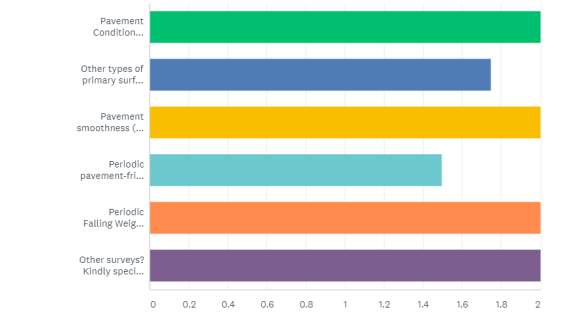
- How do you select sections of pavements that require rehabilitation treatments or maintenance?
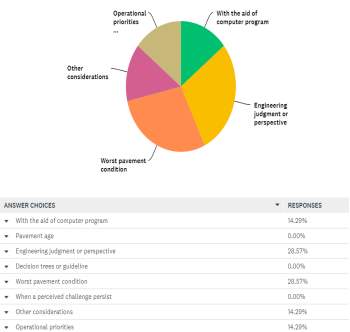 Please check any appropriate options
Please check any appropriate options
 With the aid of computer program
With the aid of computer program Pavement age
Pavement age- Engineering judgment or perspective
 Decision trees or guideline
Decision trees or guideline Worst pavement condition
Worst pavement condition When a perceived challenge persists
When a perceived challenge persists Other considerations
Other considerations Operational priorities
Operational priorities
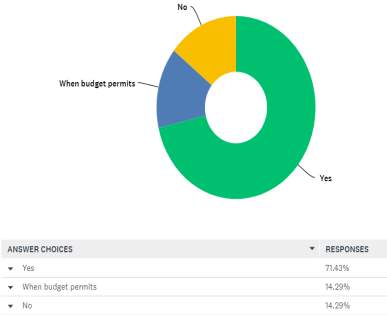 Do you methodically identify pavements which would benefit significantly from preventive maintenance/treatment?
Do you methodically identify pavements which would benefit significantly from preventive maintenance/treatment?
- Yes
- When budget permits
- No
- Do you implement preventive maintenance/treatment at the most appropriate time?
- Yes
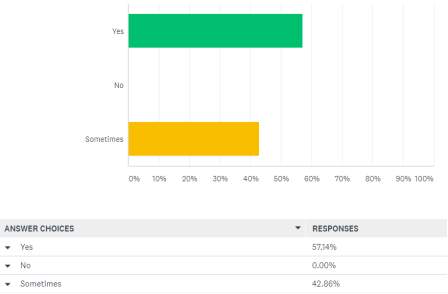 No
No- Sometimes
- Has your agency currently (during last 10-year period) evaluated the performance of unquestionable pavement treatments or maintenance? (We are primarily interested in new and clean innovative pavement preservation-treatments and technologies.)
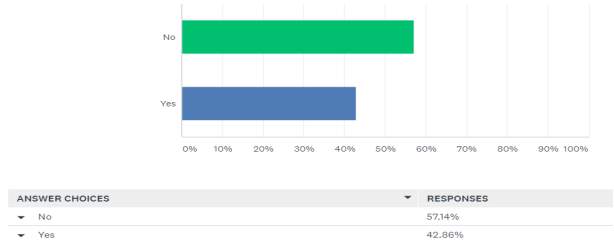 No
No- Yes
- How do you get funding for routine pavement rehabilitation and maintenance? Please check all necessary boxes.
 Based on last-year budget
Based on last-year budget Based on pavement-requirements such a PCI-level
Based on pavement-requirements such a PCI-level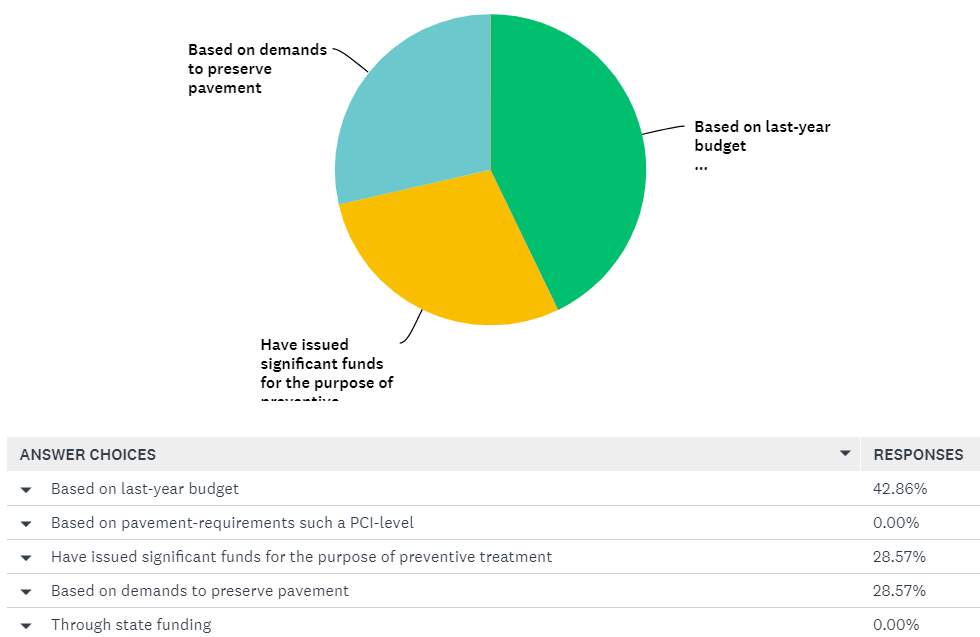 Have issued significant funds for the purpose of preventive treatment
Have issued significant funds for the purpose of preventive treatment 
 Based on demands to preserve pavement
Based on demands to preserve pavement Through state funding
Through state funding
- Does your Organization have any full or part-time staff devoted to pavement management?
- Yes, if yes, how many hours per week do they work?
- No, if no, please explain the situation

- Who makes the final decision on maintenance and reconstruction projects?
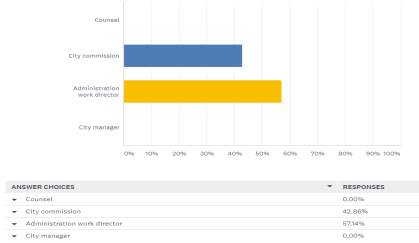 Counsel
Counsel- City Commission
- Administration work director
- City manager
- How do you save the pavement data?
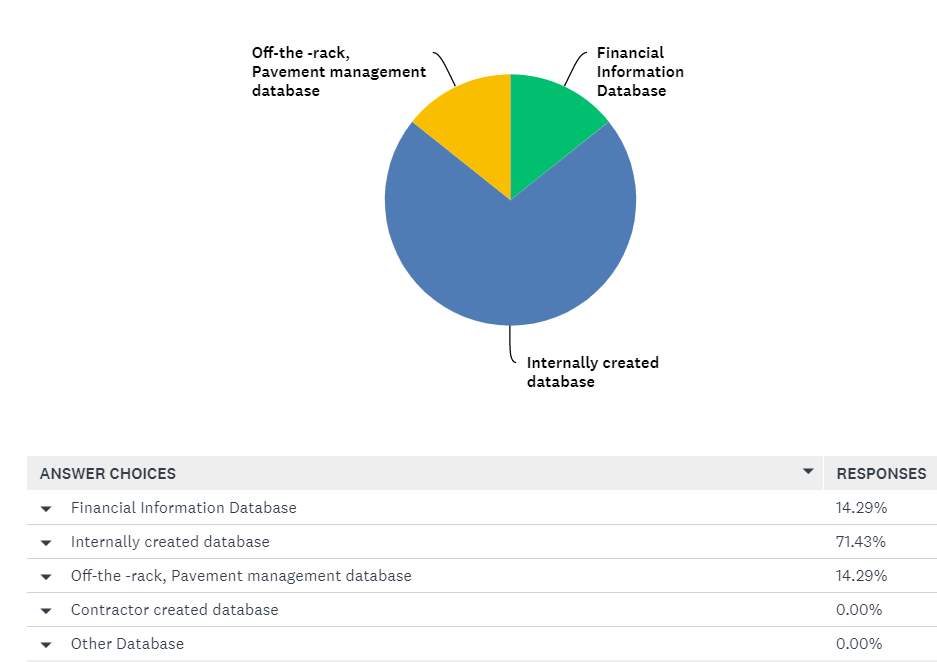 Financial Information Database
Financial Information Database- Internally created database
- Off-the-rack, Pavement management database
- Contractor created database
- Other Database
 How often is the data collected? If data is collected only once or at regular intervals when were they collected lastly?
How often is the data collected? If data is collected only once or at regular intervals when were they collected lastly?

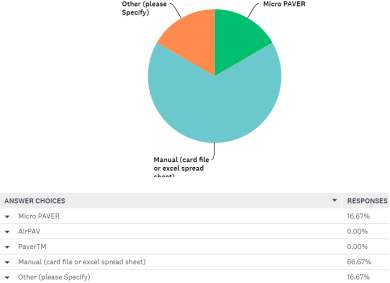 Which pavement management system software packages are used?
Which pavement management system software packages are used?
- Micro PAVER
- AirPAV
- PaverTM
- Manual (card file or excel spreadsheet)
- Other (Please Specify)
 Which roadway pavement data are most crucial in your firm’s view for the anthology between two projects i.e., between a bridge project and pavement projects?
Which roadway pavement data are most crucial in your firm’s view for the anthology between two projects i.e., between a bridge project and pavement projects?
- Location
- Attributes/ Characteristics
- Structural condition
- Functional condition
- Initial firm costs
- Life-cycle costs
- Utilization
- Customer responses & complaint.
- Which of the listed statements below best illustrates how your institution decides which information will be obtained to support the decisions for the selected project? Check all options that apply: Data collection-decisions are:
- Based on recorded practice and staff experience denied by the firm/company (firm and staff culture)
- Based on widely accepted data collection standards
- Based on particular needs of individual or integrated management system/ decision processes to be supported
- Don’t know precisely
- Please list any other considerations that your company data collection responses decisions are based on
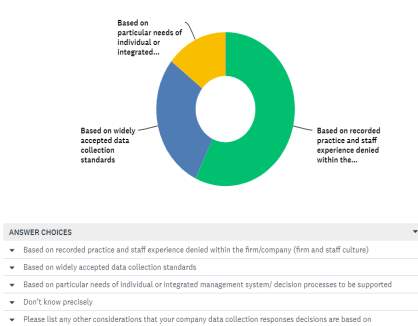
- What is the estimated budget of the roadway pavement and did the organization succeeded in completing it in the planned budget? If not, what is the approximate budget difference?


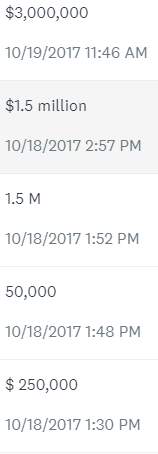 What is the budget allotted for the maintenance of the roadway pavement?
What is the budget allotted for the maintenance of the roadway pavement?
- Please describe the leadership level(s) that are defined exactly by your firm/company

REFERENCES
Dave Johnson, P. (2017). Pavement management basics and benefits: A strategy of prevention. Retrieved from ASPHALT: http://asphaltmagazine.com/pavement-management-basics-and-benefits-a-strategy-of-prevention/
Farrukh Sohail, T. D. (2016). IMPLEMENTATION . Center for Transportation Research University of Texas at Austin.
transportation.ky.gov/Maintenance. (2014). Operations and Pavement Management. Retrieved from KENTUCKY TRANSPORTATION CABINET: http://transportation.ky.gov/Maintenance/Pages/Pavement-and-Operations.aspx
www.agileassets.com. (2017). Texas Department of Transportation Selects AgileAssets’ Pavement Analyst as New Pavement Management System. Retrieved from AGILEASSETS: https://www.agileassets.com/
www.constructionequipment.com. (2016). Timely Treatments Preserve Pavements. Retrieved from CONSTRUCTION EQUIPMENT: https://www.constructionequipment.com/timely-treatments-preserve-pavements
www.fhwa.dot.gov. (2017, 09 18). Pavement Management & Performance. Retrieved from Federal Highway Administration: https://www.fhwa.dot.gov/pavement/mana.cfm
www.nra.co.za. (2017). Periodic Maintenance . Retrieved from SANRAL: http://www.nra.co.za/live/content.php?Session_ID=7cf49ec1992fed291570c2f95eb89886&Category_ID=114
www.scdot.org. (2015, 4 15). Road and Highway Rehabilitation. Retrieved from Doing Business with SCDOT: http://www.scdot.org/doing/Pavement_Preservation/rehabilitation.asp
Himeno, K., Yuge, F., Ishitani, M., Kameyama, S., & Kasahara, A. (2011). Optimization Of Pavement Maintenance And Rehabilitation Strategy Considering Its Bearing Capacity. Journal Of Pavement Engineering, Jsce, 2, 17-22. Http://Dx.Doi.Org/10.2208/Journalpe.2.17
Sainfort, F., Fryback, D., Deichtmann, J., Ross, F., Shober, S., Decabooter, P., & Weiss, K. (2013). A Pavement Management Decision Support System. Production and Operations Management, 3(1), 2-20. Http://Dx.Doi.Org/10.1111/J.1937-5956.1994.Tb00106.X
Satoh, O., Takemoto, H., & Suzuki, T. (2014). Analysis of The Benefits and Usability Of Oren-Graded Joint Pavement. Journal of Pavement Engineering, Jsce, 9, 95-100. Http://Dx.Doi.Org/10.2208/Journalpe.9.95
www.pavementinteractive.org. (2011, 8 09). Pavement Management Systems – Informed Decision Making for Roadways. Retrieved from Pavement Interactive:
www.fhwa.dot.gov. (2017, Jan 31). Evaluation of Pavement Safety Performance. Retrieved from Federal Highway Administration: https://www.fhwa.dot.gov/publications/research/safety/14065/004.cfm
www.asphaltinstitute.org. (2017). asphalt institute. Retrieved from Pavement Management System: http://www.asphaltinstitute.org/pavement-management-systems/
www.asphaltwa.com. (2010). Pavement Management . Retrieved from Washington Asphalt Pavement Association: http://www.asphaltwa.com/pavement-evaluation-pavement-management/
Deloitte. 2012. Improving Public Sector Property Management. Office Politics. http://www2.deloitte.com/content/dam/Deloitte/global/Documents/Public-Sector/dttl-ps-officepolitics-08082013.pdf
Cite This Work
To export a reference to this article please select a referencing stye below:
Related Services
View allRelated Content
All TagsContent relating to: "Public Sector"
The Public Sector is home to all public services and any enterprises that are publicly funded. This includes all emergency services, the military, healthcare services, education, infrastructure, and more.
Related Articles
DMCA / Removal Request
If you are the original writer of this dissertation and no longer wish to have your work published on the UKDiss.com website then please:




